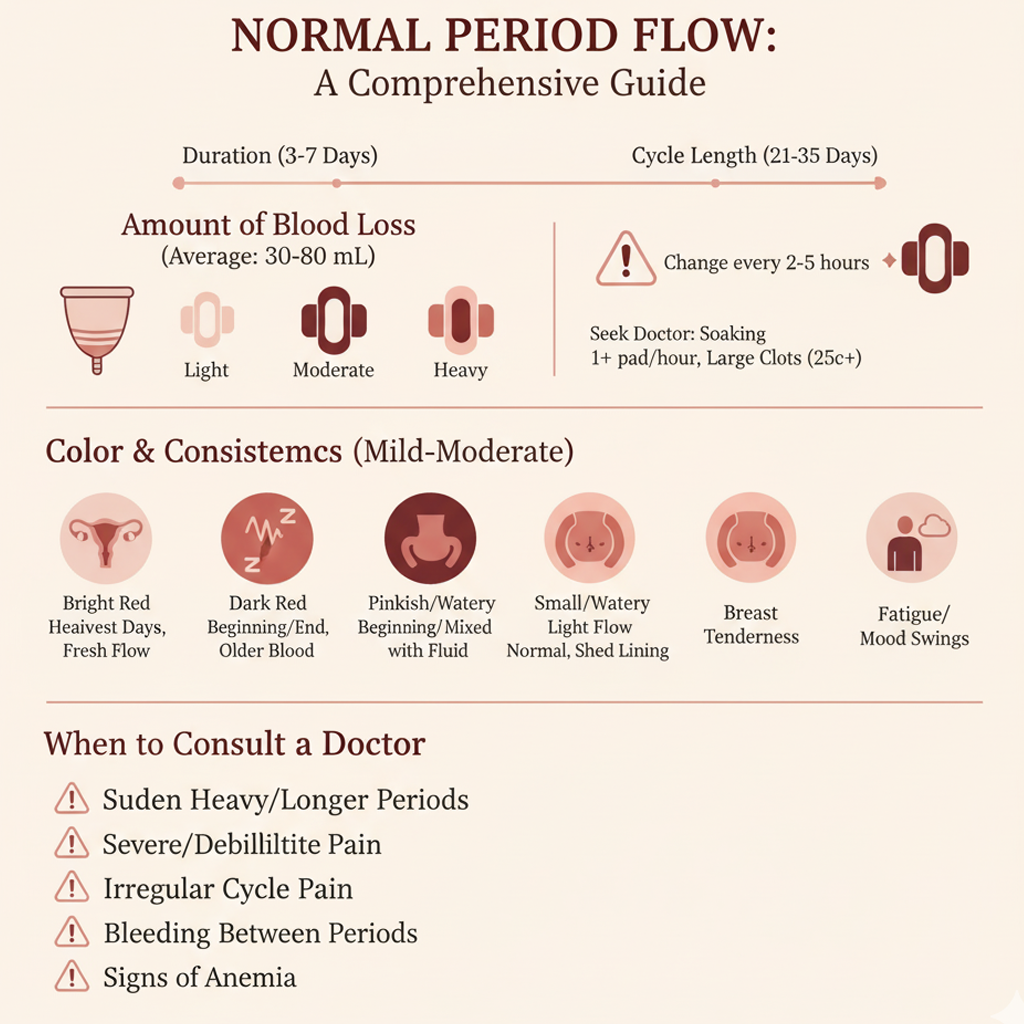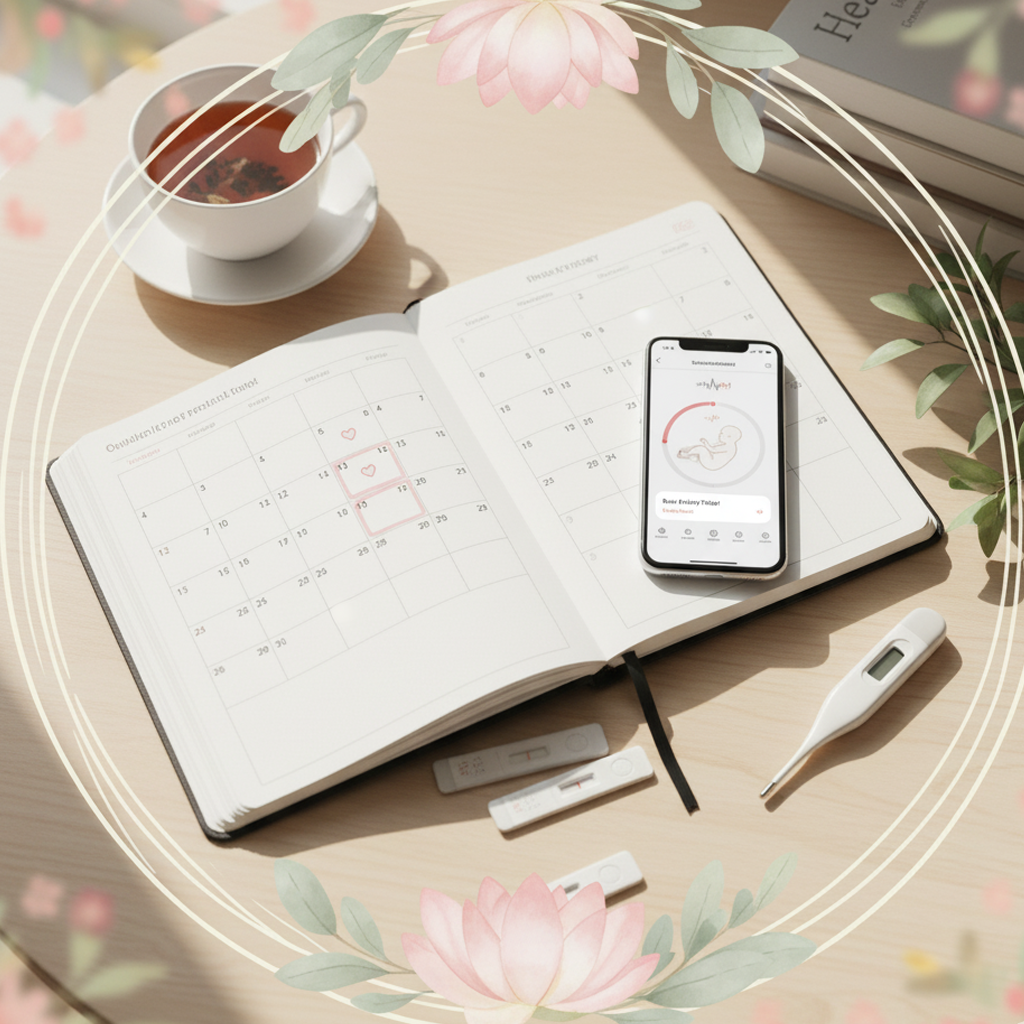Normal Period Flow

Understanding what constitutes a normal period flow is key to monitoring reproductive health and identifying potential issues. By tracking flow, duration, and associated symptoms, you can establish your baseline and recognize when changes warrant medical attention. This guide outlines typical characteristics of menstrual flow and provides practical tips for tracking. Always consult a healthcare provider if you notice unusual patterns or have concerns about your cycle.
1. Characteristics of Normal Period Flow
-
Duration: Typically lasts 3–7 days, with most bleeding occurring in the first 2–4 days.
-
Volume: Average blood loss is 30–80 ml per cycle (about 2–5 tablespoons). Normal flow may require changing a pad or tampon every 2–4 hours on heavier days, with lighter flow toward the end.
-
Color and Consistency:
-
Bright red or dark red blood is common, especially on heavier days.
-
Light pink or brown spotting may occur at the start or end of the period.
-
Small clots (less than a quarter in size) are normal, particularly during heavy flow.
-
-
Cycle Length: A normal menstrual cycle ranges from 21–35 days (28 days on average), measured from the first day of one period to the first day of the next.
-
Purpose: Defines a baseline for typical flow to help distinguish normal variations from potential concerns.
2. Common Symptoms Associated with Normal Flow
-
Mild to Moderate Cramping: Caused by uterine contractions, often felt in the lower abdomen or back. Over-the-counter pain relievers or a heating pad can help manage discomfort.
-
Fatigue or Mood Changes: Hormonal fluctuations may cause mild tiredness, irritability, or emotional sensitivity.
-
Breast Tenderness: Common before or during the period due to progesterone changes.
-
Bloating: Fluid retention may occur, especially in the days leading up to menstruation.
-
Purpose: Recognizing typical symptoms helps differentiate them from abnormal signs requiring attention.
3. Tracking Your Period Flow
-
Action: Use a notebook, calendar, or digital reminder system to log:
-
Start and end dates of your period.
-
Flow intensity (e.g., light, moderate, heavy) and frequency of pad/tampon changes.
-
Color, consistency, and presence of clots.
-
Associated symptoms (e.g., cramps, fatigue) and their severity.
-
-
Tracking Tips:
-
Note flow changes daily (e.g., “Day 2: heavy flow, changed pad every 3 hours”).
-
Track for 3–6 months to establish your normal pattern.
-
Use a simple scale (e.g., light = spotting, moderate = regular changes, heavy = soaking a pad/tampon in 1–2 hours).
-
-
Purpose: Builds a record to identify your baseline and detect irregularities over time.
4. Normal Variations in Flow
-
Cycle-to-Cycle Variations: Slight changes in flow, duration, or symptoms are normal due to factors like stress, diet, or exercise.
-
Age-Related Changes:
-
Adolescents (first few years of menstruation): Cycles may be irregular, with heavier or lighter flow.
-
Perimenopause (late 30s to 40s): Flow may become heavier or lighter as ovulation becomes less predictable.
-
-
Lifestyle Factors: Travel, weight changes, or intense exercise can temporarily alter flow.
-
Purpose: Understanding variations prevents unnecessary worry and helps identify when changes are significant.
5. Warning Signs Requiring Medical Attention
Contact a healthcare provider if you experience:
-
Heavy Flow: Soaking a pad or tampon every 1–2 hours for several hours or passing large clots (bigger than a quarter).
-
Prolonged Bleeding: Periods lasting longer than 7 days or spotting between cycles.
-
Severe Pain: Intense cramping that interferes with daily activities or doesn’t respond to pain relief.
-
Irregular Cycles: Cycles consistently shorter than 21 days or longer than 35 days, or missing periods without pregnancy.
-
Other Symptoms: Unusual fatigue, dizziness, pale skin, or signs of anemia (e.g., shortness of breath), which may indicate excessive blood loss.
-
Purpose: Ensures timely evaluation for conditions like fibroids, endometriosis, polycystic ovary syndrome (PCOS), or hormonal imbalances.
6. Support Reproductive Health
-
Nutrition: Maintain a balanced diet with iron-rich foods (e.g., leafy greens, lean meats) to replenish blood loss and support energy levels.
-
Hydration: Drink 8–10 cups of water daily to reduce bloating and support overall health.
-
Stress Management: Practice 10-minute daily relaxation techniques (e.g., deep breathing, meditation) to minimize stress-related cycle disruptions.
-
Exercise: Engage in moderate activity (e.g., 150 minutes weekly of walking or yoga) to promote hormonal balance without overexertion.
-
Purpose: Supports regular cycles and reduces symptoms like cramping or fatigue.
7. Involve Your Partner or Support System
-
Shared Tracking: Share your tracking routine with your partner to discuss symptoms or concerns, especially if planning for pregnancy.
-
Emotional Support: Talk about mood changes or discomfort to build understanding and reduce stress.
-
Purpose: Strengthens teamwork and fosters open communication about reproductive health.
Benefits
-
Reproductive Health Awareness: Tracking flow establishes your normal pattern, aiding fertility planning or early issue detection.
-
Empowered Monitoring: Helps you communicate effectively with your healthcare provider about changes or concerns.
-
Reduced Anxiety: Understanding normal flow variations promotes confidence in your body’s processes.
Practical Tips
-
Tracking Tools: Use a paper calendar or phone-based reminder to log period start/end dates, flow intensity, and symptoms. Record daily for consistency.
-
Flow Assessment: Count pad/tampon changes to estimate volume (e.g., 1–2 per day = light, 3–5 = moderate, 6+ = heavy).
-
Symptom Management: Apply a heating pad for cramps or try gentle stretching to ease discomfort. Note what works in your log.
-
Dietary Support: Include iron-rich foods (e.g., spinach, lentils) and vitamin C sources (e.g., oranges) to enhance iron absorption, especially during heavier periods.
-
Warning Sign Log: Note any abnormal symptoms (e.g., large clots, severe pain) with dates and details to share with your provider.
-
Regular Checkups: Discuss period patterns during routine health visits to ensure ongoing reproductive health.
Actionable Next Steps
-
Today: Choose a tracking tool and log the start date and flow details of your current or next period.
-
This Week: Begin recording daily flow intensity, symptoms, and any pain relief methods used.
-
Next 3–6 Months: Track consistently to establish your normal flow pattern. Review for variations or irregularities.
-
Ongoing: Consult a healthcare provider if you notice warning signs or have concerns about your period flow or cycle.
Related Articles

Week 6 - Limb Buds Appear

Week 1 - Early Pregnancy

Week 21 - Eyebrows Form

Week 40 - Ready for Birth

Ovulation Prediction

Week 23 - Skin Thins

Pregnancy Test Calculator

Week 5 - Heartbeat Begins